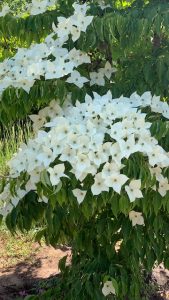 WHAT is it?
WHAT is it?
Homegrown National Park is an effort to encourage the planting of native species in existing gardens, farms and forests to support the biodiversity of life that is under threat. The goal of HNP is to replace one-half of all lawns in the U.S. (20 million acres!) with native plantings.
WHY is it important?
More than a quarter of our bird life (2.9 million birds) has been lost since 1970, insects are in decline and a quarter of all North American bumblebee species are at risk of extinction. Reasons are many, but a major cause is the widespread loss of the native plant species these populations depend on. For example, birds depend on a healthy supply of insects and caterpillars to raise their young, and non-native “insect-resistant” species provide them with little to no sustenance. If we continue this trajectory, we will ultimately lose the life support system that nature provides humans.
Doug Tallamy, PhD., the author of Nature’s Best Hope, has spent a lifetime studying the relationships between wildlife and native plants. Based on that understanding he offers us a way to reverse course. He has turned his idea into a national movement called Homegrown National Park. This concept extends the idea of “parks” into our yards and communities by incorporating native species, minimizing pesticides, and removing invasive species; thereby creating “ribbons” of connected habitat in our own neighborhoods.
HOW do I get started?
Get on the Map! The HNP brochure outlines the steps we can take that will make a difference. These are universal principles; however, #3- “Planting the plants that do the most good” requires identifying plants native to the Willamette Valley.
Keystone species are the native plants that host the greatest variety of moth and butterfly caterpillars in a given area. The National Wildlife Federation has created a database that ranks plant genera in every U.S. county based upon this criteria (www.nwf.org/NativePlantFinder). According to Tallamy, if your yard lacks keystone species, the food web you are trying to build may fail. Start with a few keystone trees and shrubs, adapted to your growing conditions, and fill in with pollinator plants that attract the most native pollinator species.
Willamette Valley “Keystone” Native Plants:
Trees:
- White oak (Quercus garryana)
- Chokecherry (Prunus virginiana)
- Scouler’s willow (Salix scouleriana)
- Black cottonwood (Populus balsamifera)
- White alder (Alnus rhombifolia)
- Red alder (Alnus rubra)
- Big leaf maple (Acer macrophyllum)
- Vine maple (Acer circinatum)
- Water birch (Betula occidentalis)
- Paper birch (Betula papyrifera)
Shrubs:
- Red huckleberry (Vaccinium parvifolium)
- Blueblossom (Ceanothus thyrsiflorus)
- Buckbrush (Ceanothus cuneatus)
- Pacific dogwood (Cornus nuttalii)
- Red-osier dogwood (Cornus sericea)
- Black hawthorn (Crataegus douglasii)
- Salmonberry (Rubus spectabilis)
- Oceanspray (Holodiscus discolor)
- Blue elderberry (Sambucus caerulea)
- Red elderberry (Sambucus racemosa)
- Snowberry (Symphoricarpos albus)
- Creeping snowberry (Symphoricarpos mollis)
Perennials and garden flowers (primarily pollinator plants):
- Canada goldenrod (Solidago canadensis)
- California poppy (Eschscholzia california)
- Farewell-to-spring (Clarkia amoena)
- Douglas aster (Symphotrichum subspicatum)
- Globe gilia (Gilia capitata)
- Oregon sunshine (Eriophyllum lanatum)
- Rose checker-mallow (Sidalcea virgata)
- Thimbleberry (Rubus parviflorus)
- Varileaf phacelia (Phacelia heterophylla)
- Yarrow (Achillea millefolium)
WHO can I contact for Help?
- Garden designers to help you plan:
- Local nurseries to purchase plants and seeds:
- Willamette Gardens (Willamettegardens.com) native plants exclusively, by appt only
- Willamette Wildlings Native Plant & Seed (willamettewildlings.com)
- Seven Oaks (sevenoaksnativenursery.com ) wholesale only
- Dancing Oaks (dancingoaks.com) some natives
- Shonnards (shonnards.com) some natives
- Garland Nursery (garlandnursery.com) some natives
- Homegrown Gardens (homegrowngardens.biz) some natives
- Doak Creek Native Plant Nursery, Eugene, www.doakcreeknursery.com
WHERE can I find out more?
- Homegrown National Park (homegrownnationalpark.org)
- Nature’s Best Hope by Dr. Tallamy
- Real Gardens Grow Natives by Eileen Stark
- Gardening with Native Plants in the Pacific Northwest by Arthur R. Kruckeberg
- All available at your local bookseller or Amazon
